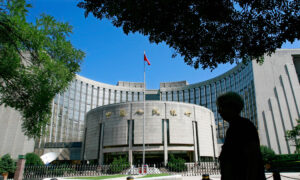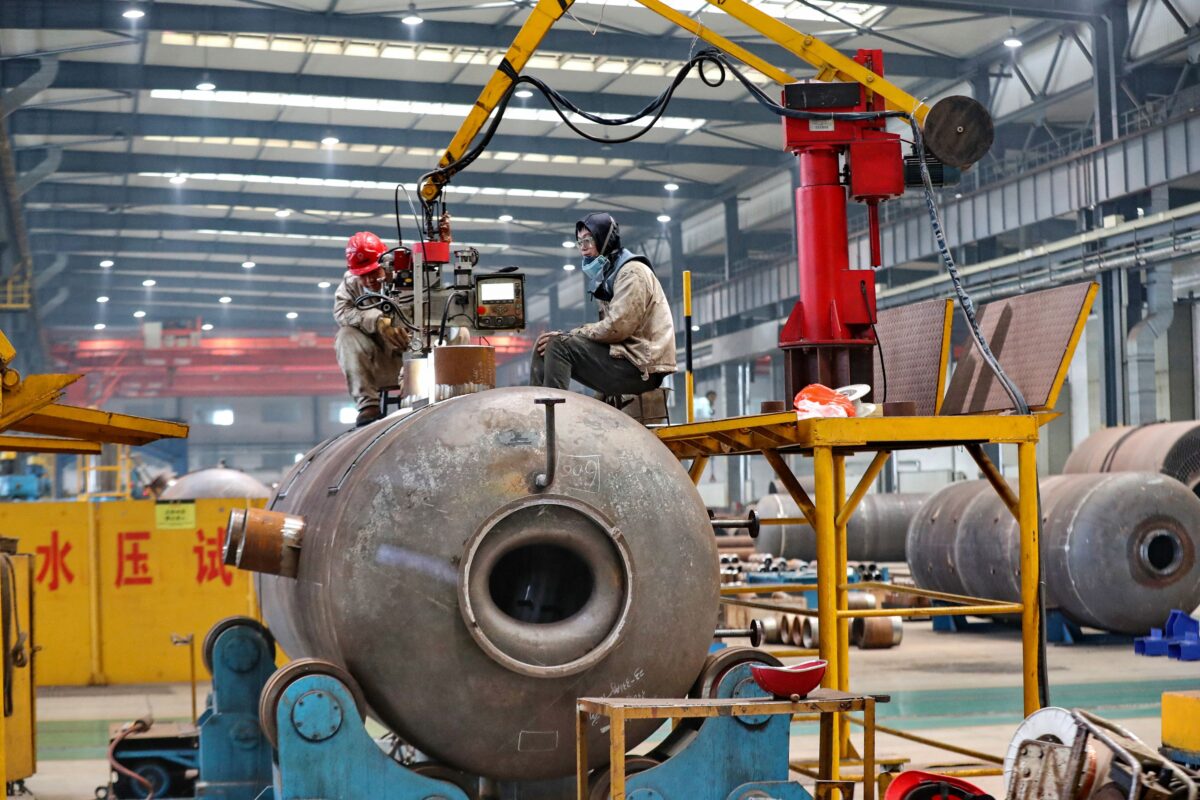China’s Economy Stepping into a Downward Spiral with Two Major Risks: Analysis
News Analysis China’s economy is moving into a downward spiral in the medium-to-long term due to demographic headwinds and declining productivity after it slowed down substantially in 2022 with GDP growth reaching its second lowest since 1977. The International Monetary Fund (IMF), although expecting China’s economy to rebound in the short term, revised its medium-term growth forecast on Feb. 3, with the GDP growth being depreciated to 3.8 percent in 2027, compared to its previous projection of 4.6 percent. Such a downward trend will be expected to remain in 2025–2027, reflecting the persistent economic challenges in China. The Asian Development Bank (ADB) made a longer-term forecast in its report published (pdf) in December 2022, predicting a gradual decline in China’s economic growth from an average of 5.3 percent in 2020–2025 to an average of 2 percent in 2036–2040. A shrinking working-age population will increasingly weigh on China’s growth, according to the report. Deteriorating Demographics More and more Chinese enterprises complained that it is not easy to recruit workers nowadays. Just a few days after the Chinese New Year, local governments in some coastal provinces such as Guangdong, Zhejiang, Jiangsu, and Fujian have already organized enterprises to recruit workers across provinces. For example, on Feb. 2, recruiters were seen in long queues waiting for job seekers in Haizhu District, Guangzhou City, Guangdong Province. China, the world’s factory, is likely to lose the position it once held as it is short of a sufficient workforce. The country’s working-age population shrank for consecutive nine years from 2012–2020. Population aged 16–59, although it rebounded slightly in 2021, it declined again in 2022 by 6.66 million, according to the National Bureau of Statistics. A migrant worker who was evicted from his room in a low-income housing area sits on the roof of a house where he has been staying, as he waits to receive his salary before returning to his home in the south of the country, at a migrant village on the outskirts of Beijing, on Dec. 11, 2017, (Nicolas Asfouri/AFP via Getty Images) Population plays a critical role in economic growth as labor is one of the standard input factors and the shrinkage of the workforce will directly affect total outputs. China’s demographic issues, which take decades to resolve, make the economic downturn hard to reverse. The total population shrank in 2022, the first time since the 1960s, according to the official announcement. This comes with a low birth rate and an aging population. The birth rate was 6.77 percent in 2022, a record low level since 1978 and far below the 10.41 percent in 2019 before the pandemic. The declining birth rate indicates a lower number of people reaching working age in the next 15–20 years. Meanwhile, the acceleration of the aging population has taken away the demographic dividend for the nation’s economic development. The year 2022 was called the “first year of accelerated aging in China” by Prof. Luo Shougui of the Antai College of Economics and Management at Shanghai Jiao Tong University. The baby boomers in 1962–1975 will gradually reach retirement age in the next decade. The newly retired population is highly likely to be more than 20 million per year, as there were around 21–29 million births each year in China from 1962 to 1975. Some may argue that the declining working force can be offset by increased productivity. However, a shrinking population has an adverse impact on the total factor productivity due to the smaller sector labor shift. Dominik Peschel, an economist at the Asian Development Bank, stated that “the contribution of total factor productivity to growth is estimated to be smaller in the next two decades because of a much smaller contribution from the sectoral labor shift and lower returns to R&D.” “The speed of migration from agriculture into industry and services is expected to moderate over time. This is because the share of the workforce employed in agriculture has already fallen substantially,” he said. Workers examine a waste-to-energy incinerator at a factory in Nantong, in China’s eastern Jiangsu province on Feb. 6, 2023. (STR/AFP via Getty Images) A Vicious Cycle of Low Output Productivity growth presents weak, in large part because of the role of low-productivity state-owned enterprises (SOEs) and declining business dynamism, said IMF. Chinese SOEs are notorious for their low productivity. Emilia M Jurzyk, a senior economist at the IMF, documented in 2021 that publicly listed SOEs are less productive and profitable than publicly listed firms in which the state has no ownership stake. Chinese SOEs usually have much better funding access than non-SOEs, as the banking industry is dominated by state-owned institutions. On the contrary, non-SOEs, which have higher operating efficiency, are difficult to finance in the market. This leads to a misallocation of funds, which not only lower

News Analysis
China’s economy is moving into a downward spiral in the medium-to-long term due to demographic headwinds and declining productivity after it slowed down substantially in 2022 with GDP growth reaching its second lowest since 1977.
The International Monetary Fund (IMF), although expecting China’s economy to rebound in the short term, revised its medium-term growth forecast on Feb. 3, with the GDP growth being depreciated to 3.8 percent in 2027, compared to its previous projection of 4.6 percent. Such a downward trend will be expected to remain in 2025–2027, reflecting the persistent economic challenges in China.
The Asian Development Bank (ADB) made a longer-term forecast in its report published (pdf) in December 2022, predicting a gradual decline in China’s economic growth from an average of 5.3 percent in 2020–2025 to an average of 2 percent in 2036–2040.
A shrinking working-age population will increasingly weigh on China’s growth, according to the report.
Deteriorating Demographics
More and more Chinese enterprises complained that it is not easy to recruit workers nowadays. Just a few days after the Chinese New Year, local governments in some coastal provinces such as Guangdong, Zhejiang, Jiangsu, and Fujian have already organized enterprises to recruit workers across provinces. For example, on Feb. 2, recruiters were seen in long queues waiting for job seekers in Haizhu District, Guangzhou City, Guangdong Province.
China, the world’s factory, is likely to lose the position it once held as it is short of a sufficient workforce.
The country’s working-age population shrank for consecutive nine years from 2012–2020. Population aged 16–59, although it rebounded slightly in 2021, it declined again in 2022 by 6.66 million, according to the National Bureau of Statistics.

Population plays a critical role in economic growth as labor is one of the standard input factors and the shrinkage of the workforce will directly affect total outputs. China’s demographic issues, which take decades to resolve, make the economic downturn hard to reverse.
The total population shrank in 2022, the first time since the 1960s, according to the official announcement. This comes with a low birth rate and an aging population. The birth rate was 6.77 percent in 2022, a record low level since 1978 and far below the 10.41 percent in 2019 before the pandemic. The declining birth rate indicates a lower number of people reaching working age in the next 15–20 years.
Meanwhile, the acceleration of the aging population has taken away the demographic dividend for the nation’s economic development. The year 2022 was called the “first year of accelerated aging in China” by Prof. Luo Shougui of the Antai College of Economics and Management at Shanghai Jiao Tong University. The baby boomers in 1962–1975 will gradually reach retirement age in the next decade. The newly retired population is highly likely to be more than 20 million per year, as there were around 21–29 million births each year in China from 1962 to 1975.
Some may argue that the declining working force can be offset by increased productivity. However, a shrinking population has an adverse impact on the total factor productivity due to the smaller sector labor shift.
Dominik Peschel, an economist at the Asian Development Bank, stated that “the contribution of total factor productivity to growth is estimated to be smaller in the next two decades because of a much smaller contribution from the sectoral labor shift and lower returns to R&D.”
“The speed of migration from agriculture into industry and services is expected to moderate over time. This is because the share of the workforce employed in agriculture has already fallen substantially,” he said.

A Vicious Cycle of Low Output
Productivity growth presents weak, in large part because of the role of low-productivity state-owned enterprises (SOEs) and declining business dynamism, said IMF.
Chinese SOEs are notorious for their low productivity. Emilia M Jurzyk, a senior economist at the IMF, documented in 2021 that publicly listed SOEs are less productive and profitable than publicly listed firms in which the state has no ownership stake.
Chinese SOEs usually have much better funding access than non-SOEs, as the banking industry is dominated by state-owned institutions. On the contrary, non-SOEs, which have higher operating efficiency, are difficult to finance in the market.
This leads to a misallocation of funds, which not only lowers the overall productivity but also undermine entrepreneurs’ confidence, hindering further investment at least in the short term, and resulting in fewer production activities and layoffs in the future.
This led to a vicious cycle as fewer production activities mean lower outputs and lower economic growth. Layoffs will increase the unemployment rate, reduce people’s net income, and adversely affect consumption. Lower consumption indicates declining demand, which will further undermine entrepreneurs’ confidence, resulting in stagnant investment and sluggish business dynamism. All of this will further erode output.
As early as 2015, the Chinese Communist Party (CCP) listed the issue of difficulty to get corporate financing as one of the top five items to be reformed in the National People’s Congress and the Political Consultative Conference. The CCP also proposed to deepen the reform of SOEs in August of the same year.
After almost 8 years, non-SOEs still have difficulty accessing funding that benefits only SOEs, and low productivity will not be changed in the short term. It has a similar characteristic as the demographic issue.
Hence, the two risks, low productivity and worsening demographic, are taking steps to push the Chinese economy into a downward spiral.












